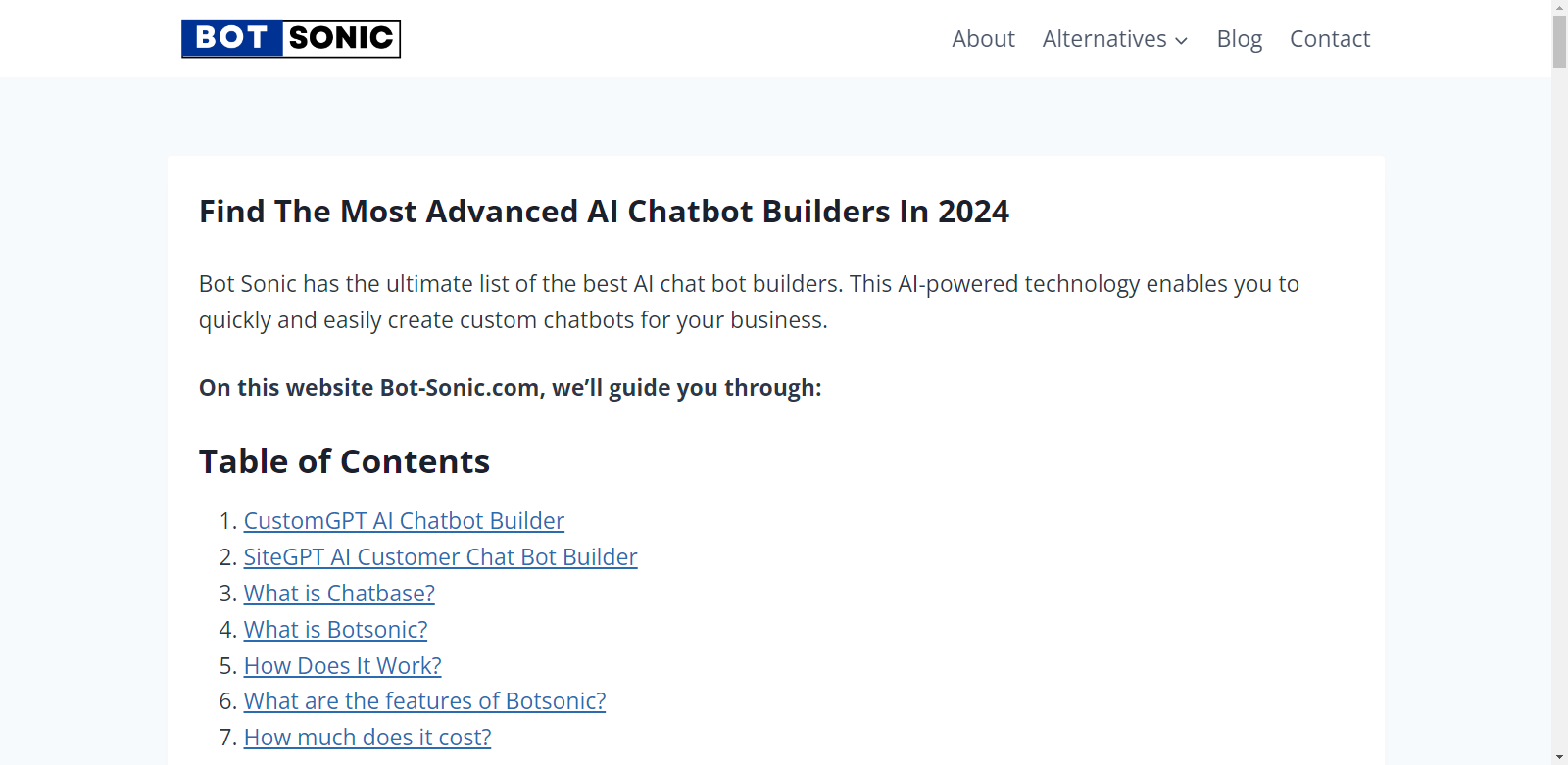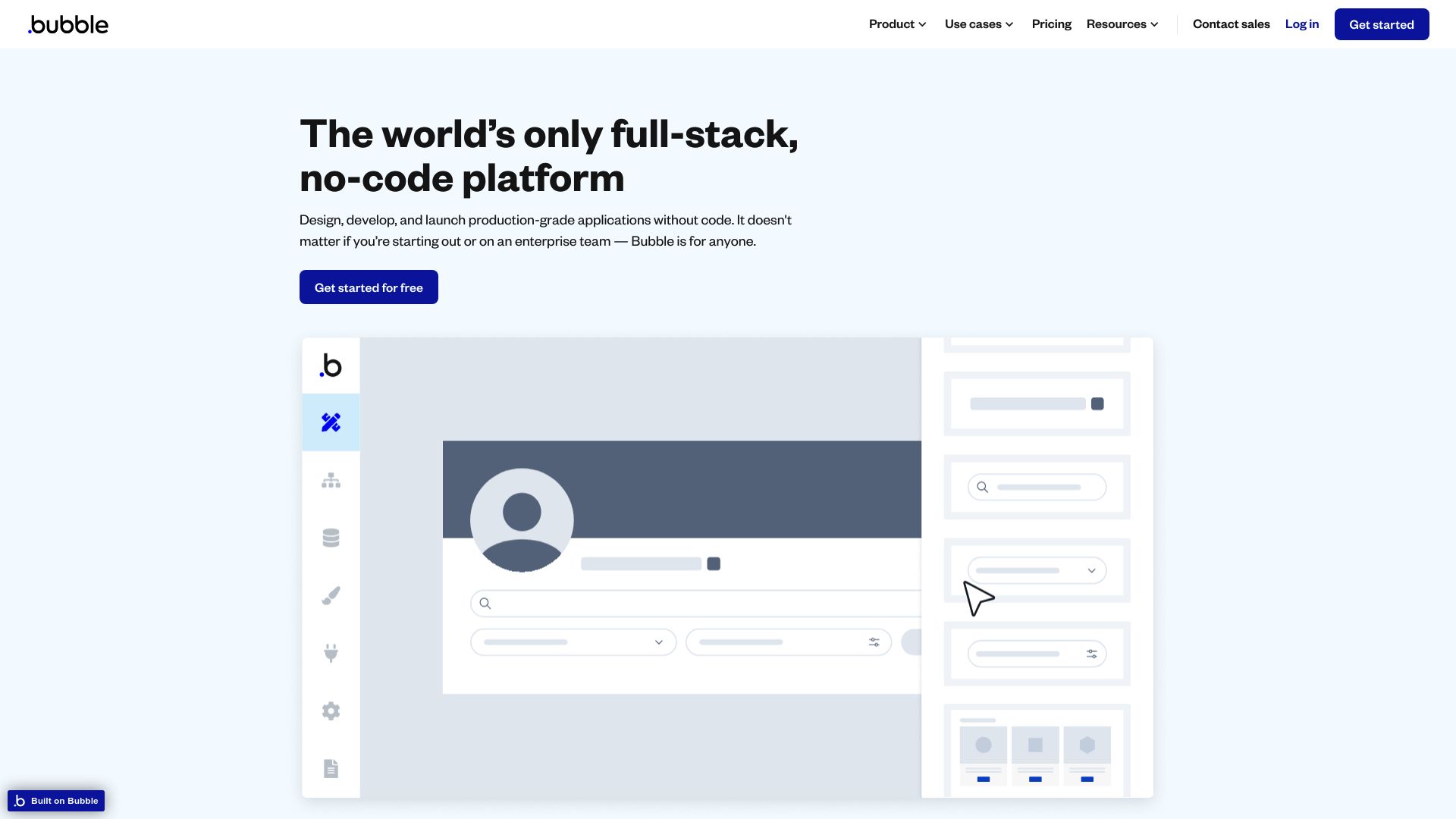Botsonic/Writesonic vs. Bubble: AI Development Platforms Compared
AI-powered development platforms are reshaping how businesses create and deploy intelligent applications. This review compares Botsonic/Writesonic, a specialized chatbot builder, with Bubble, a versatile no-code web application platform, and introduces SmythOS as a comprehensive alternative. We’ll explore each platform’s key features, strengths, and limitations to help you choose the right tool for your AI development needs.
Whether you’re a developer seeking advanced capabilities, a business leader focused on scalability, or an entrepreneur looking for user-friendly solutions, this comparison provides insights to guide your decision-making process in harnessing AI’s potential for your projects.
Botsonic/Writesonic Overview
Botsonic/Writesonic empowers businesses to create intelligent chatbots without coding expertise. This AI-powered platform leverages GPT-4 technology to deliver sophisticated conversational experiences across various industries.


Botsonic’s no-code visual builder streamlines chatbot creation, allowing users to customize appearance, behavior, and responses. The platform supports multiple languages and integrates seamlessly with popular tools like Salesforce and WhatsApp. Businesses can train chatbots using various file formats and website links, ensuring personalized interactions.
Botsonic’s no-code visual builder streamlines chatbot creation, allowing users to customize appearance, behavior, and responses.
Key features include rapid website integration, AI-powered intelligence, and extensive customization options. Botsonic aims to reduce support volume by up to 80%, freeing human agents to focus on complex issues. The platform excels in maintaining context during conversations and providing source links for enhanced transparency.
While Botsonic offers robust functionality, it lacks certain advanced features. The platform does not support multimodal inputs, constrained alignment, or a dedicated debug mode for real-time troubleshooting. Additionally, there’s no explicit mention of multi-agent collaboration or data lake integration.
Botsonic’s scalability and integration capabilities position it as a versatile solution for businesses seeking to enhance customer engagement through AI-driven chatbots. Its user-friendly approach and powerful AI foundation make it an attractive option for organizations looking to implement conversational AI without extensive technical resources.
Bubble Overview
Bubble empowers users to create web applications without coding. This no-code development platform combines a visual interface with powerful functionality, making app creation accessible to both technical and non-technical users. Bubble’s drag-and-drop editor allows for the rapid construction of complex web applications, complete with databases, workflows, and user authentication.


Bubble empowers users to create web applications without coding. This no-code development platform combines a visual interface with powerful functionality, making app creation accessible to both technical and non-technical users.
Bubble excels in its integration capabilities, particularly with AI services. Users can leverage plugins and API connectors to incorporate advanced AI functionalities like chatbots, content generation, and image processing into their applications. This feature set positions Bubble as a versatile tool for businesses looking to harness AI power without extensive development resources.
The platform’s user-friendly approach extends to its marketplace, offering pre-made templates and plugins that accelerate development. For teams, Bubble supports real-time collaboration and version control, facilitating group projects and iterative development. Built on Amazon Web Services, Bubble provides a scalable infrastructure with robust security features, including GDPR compliance and SOC 2 Type II certification.
While Bubble offers significant advantages in rapid application development and AI integration, it may have limitations for highly specialized or complex applications that require fine-grained control at the code level. Additionally, users might face a learning curve in mastering Bubble’s unique approach to application logic and database design.
Bubble’s vision of democratizing software development aligns with the growing demand for accessible tech solutions. By enabling a wider range of individuals to bring their ideas to life, Bubble is reducing barriers to entry in tech development and fostering innovation across various sectors.
Feature Comparison
Botsonic/Writesonic and Bubble offer contrasting approaches to AI-powered development, each with distinct feature sets and limitations. Botsonic/Writesonic excels in creating intelligent chatbots without coding, leveraging GPT-4 for sophisticated conversations. Its no-code visual builder and rapid website integration make it accessible for non-technical users. Bubble, on the other hand, provides a broader no-code platform for building web applications, with AI integration capabilities.
Core component differences are notable. Botsonic/Writesonic focuses on conversational AI, offering features like context retention and source link transparency. However, it lacks a dedicated debug mode and multi-agent collaboration. Bubble’s strength lies in its versatile application development environment, supporting various AI integrations through plugins and API connectors. Unlike Botsonic/Writesonic, Bubble offers real-time collaboration tools and version control, catering to team-based development.
Security features diverge significantly. While both platforms ensure data security, Bubble’s infrastructure built on Amazon Web Services provides enterprise-level security with GDPR compliance and SOC 2 Type II certification. Botsonic/Writesonic offers IP whitelisting but lacks detailed information on encryption standards. Neither platform explicitly mentions constrained alignment for ensuring strict adherence to predefined guidelines, a feature offered by more specialized AI development tools.
Feature Comparison Table
| Botsonic/Writesonic | Bubble | SmythOS | |
|---|---|---|---|
| CORE FEATURES | |||
| Visual Builder | ❌ | ✅ | ✅ |
| Memory & Context | ✅ | ❌ | ✅ |
| Autonomous Agents | ✅ | ❌ | ✅ |
| Explainability & Transparency | ✅ | ❌ | ✅ |
| Debug Tools | ❌ | ✅ | ✅ |
| Multimodal | ❌ | ❌ | ✅ |
| Multi-Agent Collaboration | ❌ | ❌ | ✅ |
| Work as Team | ❌ | ✅ | ✅ |
| Bulk Work | ❌ | ❌ | ✅ |
| Agent Work Scheduler | ❌ | ❌ | ✅ |
| SECURITY | |||
| Constrained Alignment | ❌ | ❌ | ✅ |
| Data Encryption | ❌ | ✅ | ✅ |
| OAuth | ❌ | ✅ | ✅ |
| IP Control | ✅ | ❌ | ✅ |
| COMPONENTS | |||
| Huggingface AIs | ❌ | ❌ | ✅ |
| Zapier APIs | ❌ | ✅ | ✅ |
| Classifiers | ❌ | ❌ | ✅ |
| Data Lakes | ❌ | ✅ | ✅ |
| DEPLOYMENT OPTIONS (EMBODIMENTS) | |||
| Deploy as API | ✅ | ❌ | ✅ |
| Deploy as Webhook | ❌ | ✅ | ✅ |
| Staging Domains | ❌ | ✅ | ✅ |
| API Authentication (OAuth + Key) | ❌ | ✅ | ✅ |
| Deploy as Scheduled Agent | ❌ | ❌ | ✅ |
| DATA LAKE SUPPORT | |||
| Hosted Vector Database | ❌ | ❌ | ✅ |
| Sitemap Crawler | ✅ | ❌ | ✅ |
| YouTube Transcript Crawler | ✅ | ❌ | ✅ |
| URL Crawler | ✅ | ❌ | ✅ |
Best Alternative to Botsonic/Writesonic and Bubble
SmythOS stands out as the superior alternative to Botsonic/Writesonic and Bubble, offering a comprehensive AI agent development platform that combines power, flexibility, and ease of use. We’ve designed SmythOS to address the limitations of other platforms while providing a robust set of features that cater to a wide range of AI development needs.
Unlike Botsonic/Writesonic’s focus on chatbots or Bubble’s general application development approach, SmythOS specializes in creating versatile AI agents capable of handling complex tasks across various domains. Our platform’s drag-and-drop interface makes it accessible to users of all skill levels, while still offering advanced capabilities for experienced developers.
SmythOS excels in areas where Botsonic/Writesonic and Bubble fall short. We offer multi-agent collaboration, allowing teams of AI agents to work together on complex problems. Our platform also provides a debug mode, enabling developers to fine-tune their agents’ performance. These features are absent in both Botsonic/Writesonic and Bubble, giving SmythOS a significant edge in AI agent development.
SmythOS excels in areas where Botsonic/Writesonic and Bubble fall short. We offer multi-agent collaboration, allowing teams of AI agents to work together on complex problems.
Our platform’s flexibility is unmatched. While Bubble offers integrations through plugins, SmythOS provides native support for a wide range of AI models, APIs, and data sources. This includes integration with Hugging Face models, Zapier, and various other APIs and RPAs. We also offer a hosted vector database, sitemap crawlers, and support for multiple file formats, making data management and processing effortless.
With SmythOS, we’ve prioritized scalability and security without compromising on usability. Our platform supports multiple deployment options, including APIs, webhooks, and scheduled agents. We also provide robust security features like data encryption, OAuth, and IP control. These enterprise-grade capabilities, combined with our user-friendly interface, make SmythOS the ideal choice for businesses and developers looking to harness the full potential of AI agents.
Conclusion
Botsonic/Writesonic and Bubble offer distinct approaches to AI-powered development, each with unique strengths. Botsonic/Writesonic excels in creating intelligent chatbots without coding, leveraging GPT-4 for sophisticated conversations. Its no-code visual builder and rapid website integration make it accessible for businesses seeking to enhance customer engagement. Bubble, on the other hand, provides a broader no-code platform for building web applications with AI integration capabilities, catering to a wider range of development needs.
While both platforms have their merits, SmythOS emerges as the superior choice for businesses and developers looking for a comprehensive AI development and deployment solution. SmythOS combines the best of both worlds, offering an intuitive drag-and-drop interface for building complex AI workflows without extensive coding knowledge, much like Bubble, while also providing advanced chatbot capabilities similar to Botsonic/Writesonic.
SmythOS stands out with its extensive integration ecosystem, supporting over 300,000 integrations and a wide array of AI models from providers like OpenAI, Anthropic, and Hugging Face. This versatility allows users to create sophisticated multi-agent systems that can collaborate on complex tasks, a feature not explicitly offered by either Botsonic/Writesonic or Bubble. Additionally, SmythOS’s “Create Once, Deploy Anywhere” approach enables seamless deployment across various platforms, including Google Vertex, Microsoft Copilot, and even as ChatGPT plugins or Alexa skills.
For those seeking to harness the full potential of AI in their workflows, we recommend exploring SmythOS’s capabilities. Create a free SmythOS account to experience firsthand how it can revolutionize your AI development process. With its robust features, extensive integrations, and user-friendly interface, SmythOS is poised to drive significant advancements across various industries, making it the ideal choice for businesses looking to stay at the forefront of AI innovation.
Last updated:
Disclaimer: The information presented in this article is for general informational purposes only and is provided as is. While we strive to keep the content up-to-date and accurate, we make no representations or warranties of any kind, express or implied, about the completeness, accuracy, reliability, suitability, or availability of the information contained in this article.
Any reliance you place on such information is strictly at your own risk. We reserve the right to make additions, deletions, or modifications to the contents of this article at any time without prior notice.
In no event will we be liable for any loss or damage including without limitation, indirect or consequential loss or damage, or any loss or damage whatsoever arising from loss of data, profits, or any other loss not specified herein arising out of, or in connection with, the use of this article.
Despite our best efforts, this article may contain oversights, errors, or omissions. If you notice any inaccuracies or have concerns about the content, please report them through our content feedback form. Your input helps us maintain the quality and reliability of our information.
